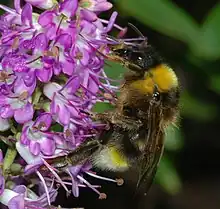| Bombus (Psithyrus) | |
|---|---|
 | |
| Bombus bohemicus | |
| Scientific classification | |
| Domain: | Eukaryota |
| Kingdom: | Animalia |
| Phylum: | Arthropoda |
| Class: | Insecta |
| Order: | Hymenoptera |
| Family: | Apidae |
| Genus: | Bombus |
| Subgenus: | Psithyrus |
| Species | |
|
See text | |
Cuckoo bumblebees are members of the subgenus Psithyrus in the bumblebee genus Bombus. Until recently, the 28 species of Psithyrus were considered to constitute a separate genus.[1][2] They are a specialized socially parasitic lineage which parasitises the nests of 'true' bumblebees, resulting in the loss of the ability to collect pollen and establish their own nests. Cuckoo bumblebees do not create a worker caste and produce only male and female reproductives. They are considered inquilines in the colonies of 'true' bumblebees.
Cuckoo bumblebee females emerge from hibernation later than their host species to ensure that their host has had sufficient time to establish a nest. Before finding and invading a host colony, a Psithyrus female feeds directly from flowers until her ovaries are sufficiently developed, at which time she begins seeking a nest to invade. Once she has located and infiltrated a host colony, the Psithyrus female usurps the nest by killing or subduing the host queen. She then lays her own eggs, exploiting the host workers to feed her and her developing young through pheromones and/or physical attacks.
Selected species
- Bombus ashtoni
- Bombus barbutellus
- Bombus bellardii
- Bombus bohemicus
- Bombus branickii
- Bombus campestris
- Bombus chinensis
- Bombus citrinus
- Bombus coreanus
- Bombus cornutus
- Bombus expolitus
- Bombus fernaldae
- Bombus ferganicus
- Bombus flavidus
- Bombus insularis
- Bombus monozonous
- Bombus morawitzianus
- Bombus norvegicus
- Bombus quadricolor
- Bombus rupestris
- Bombus skorikovi
- Bombus suckleyi
- Bombus sylvestris
- Bombus tibetanus
- Bombus turneri
- Bombus variabilis
- Bombus vestalis
Gallery
References
- ↑ Williams, P.H. 1994. Phylogenetic relationships among bumblebees (Bombus Latr.): A reappraisal of morphological evidence. Systematic Entomology 19: 327-344.
- ↑ Lhomme, Patrick; Hines, Heather M (2018-10-04). "Ecology and Evolution of Cuckoo Bumble Bees". Annals of the Entomological Society of America. 112 (3): 122–140. doi:10.1093/aesa/say031. ISSN 0013-8746.
Further reading
- Michener, C.D. (2000). The Bees of the World. Johns Hopkins University Press.
- Macdonald, M. & Nisbet, G. (2006). Highland Bumblebees: Distribution, Ecology and Conservation. HBRG, Inverness, http://www.hbrg.org.uk. ISBN 0-9552211-0-2.




